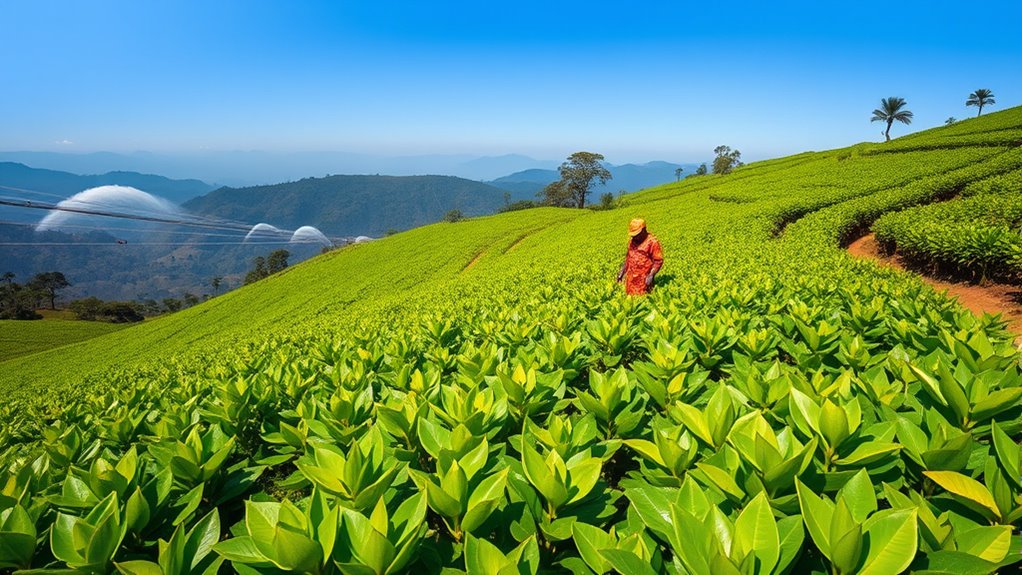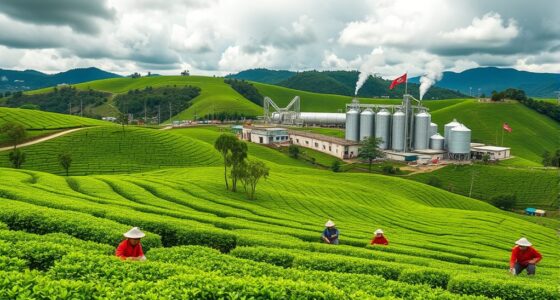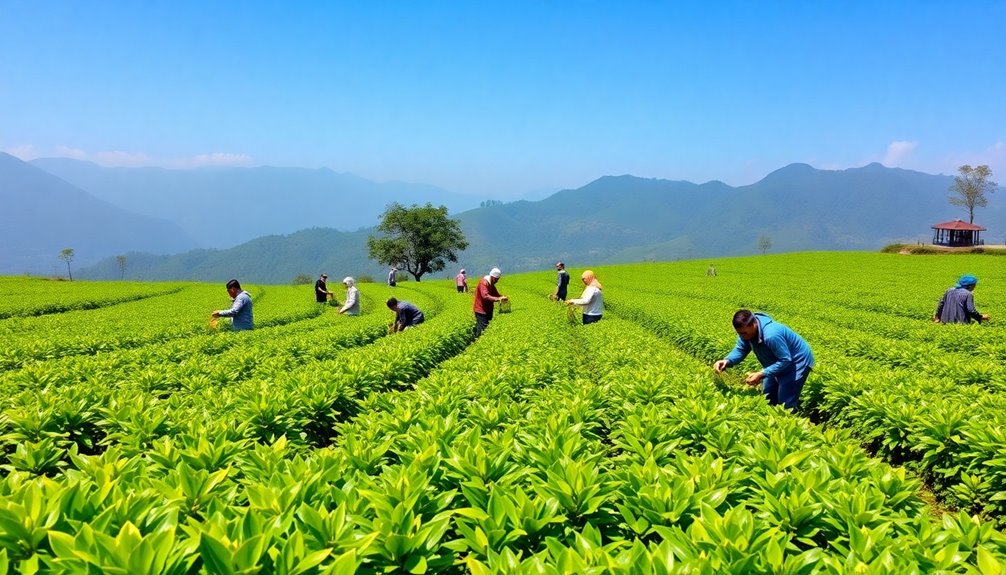Kenya’s tea industry is increasingly adopting climate-resilient cultivars to tackle rising temperatures, unpredictable rainfall, pests, and diseases. These new varieties are selected and bred for drought tolerance, heat resistance, and pest resistance, helping farmers sustain productivity amid climate challenges. By integrating these cultivars into their farms, growers can reduce crop failure risks and improve sustainability. If you want to learn how these innovations are shaping Kenya’s tea future, there’s more to discover.
Key Takeaways
- Development of climate-resilient tea cultivars is vital for sustaining Kenya’s tea industry amid rising temperatures and unpredictable weather.
- Breeding and selecting drought-tolerant, pest-resistant tea varieties help farmers adapt to climate challenges.
- Advanced research and technology accelerate the creation and adoption of resilient tea cultivars in Kenya.
- Diversifying tea cultivars reduces risks of crop failure due to climate variability and pests.
- Adoption of climate-resilient varieties ensures long-term productivity, sustainability, and profitability of Kenyan tea farms.

As climate change continues to challenge traditional tea-growing regions in Kenya, developing climate-resilient tea cultivars has become more urgent than ever. You need to understand that tea farming isn’t just about planting tea bushes; it’s about adapting to an environment that’s becoming increasingly unpredictable. Rising temperatures, unpredictable rainfall, and the threat of pests and diseases mean that the cultivars you rely on today might not perform well tomorrow. To ensure the sustainability of your tea farm, you must focus on cultivar development—creating new varieties that can withstand these changing conditions. This process involves selecting and breeding tea plants that are more tolerant to heat, drought, and pests, helping you maintain productivity despite environmental stresses.
In Kenya, cultivar development is no longer a choice but a necessity. You can’t just depend on traditional tea varieties that thrived in the past; these may now be vulnerable to the shifting climate patterns. Instead, researchers and farmers are working together to identify and propagate cultivars with enhanced resilience traits. For example, some newer cultivars are bred to be drought-tolerant, allowing them to survive and produce quality leaves even during dry spells. Others are resistant to common pests and diseases that tend to become more prevalent as climate conditions change. By integrating these resilient cultivars into your tea farming practices, you reduce the risk of crop failure and secure your livelihood.
Implementing cultivar development strategies requires you to stay informed about the latest research and to collaborate with agricultural experts. It’s about actively selecting and planting varieties that align with your farm’s specific environmental conditions. You might need to experiment with different cultivars to see which ones adapt best to your land. This proactive approach helps you build a more resilient tea farming operation capable of weathering climate fluctuations. Additionally, cultivating diverse resilient cultivars on your farm reduces dependency on a single variety, spreading the risk and ensuring steady production.
Furthermore, advancements in plant breeding techniques are accelerating the development of resilient tea cultivars, enabling quicker adaptation to climate challenges.
Ultimately, your success in tea farming hinges on your ability to adapt through cultivar development. By embracing climate-resilient cultivars, you’re not only safeguarding your harvests but also contributing to the sustainability of Kenya’s tea industry. The future of tea farming in Kenya depends on your willingness to adopt innovative practices that respond to climate challenges. Developing and cultivating resilient tea varieties is your best tool to ensure that your farm remains productive, profitable, and resilient in the face of a changing climate.
Frequently Asked Questions
How Are These New Cultivars Affecting Local Tea Farmers’ Income?
You’ll find that these new cultivars boost your farmer income by increasing yields and resilience to climate change. With better crop performance, you gain improved market access, allowing you to sell more consistently and at higher prices. As your harvests become more reliable, you may also access new markets, further enhancing your income. Overall, adopting these cultivars helps secure your livelihood and strengthens your position in the tea industry.
What Are the Environmental Impacts of Cultivating Climate-Resilient Tea?
Think of cultivating climate-resilient tea as tending a delicate garden. You help reduce soil degradation by improving soil health, and you promote water conservation, ensuring the land stays lush and productive. These practices lessen environmental strain, preventing erosion and conserving essential resources. By choosing resilient cultivars, you’re not just growing tea—you’re nurturing an ecosystem that adapts to climate changes, safeguarding the environment for future generations.
Are There Any Challenges in Adopting These New Tea Varieties?
You might face challenges in adopting new tea varieties as farmer adaptation takes time and effort. Cultivar acceptance can be slow if farmers are hesitant to switch from familiar types or doubt the benefits. You’ll need to learn new cultivation practices and trust the resilience of these cultivars. Overcoming resistance and ensuring proper training are key to successfully integrating climate-resilient tea into your farming routine.
How Do These Cultivars Influence Tea Quality and Flavor?
Imagine your favorite symphony, where each instrument plays perfectly in harmony. These new tea cultivars act like skilled musicians, enhancing flavor and ensuring quality consistency. They bring subtle flavor enhancement, elevating your tea experience, while maintaining the desired aroma and robustness. By adapting to changing climates, they help you enjoy a consistent, high-quality brew, making each cup a symphony of taste, no matter the weather.
What Government Policies Support Climate-Resilient Tea Cultivation?
You’ll find that government policies support climate-resilient tea cultivation through policy incentives like subsidies and tax breaks, encouraging farmers to adopt new cultivars. Additionally, research funding boosts development and dissemination of resilient varieties, ensuring farmers have access to better tools and knowledge. These measures help farmers adapt to climate change, improve productivity, and sustain tea quality, ultimately securing Kenya’s position as a leading global tea producer.
Conclusion
As you see, developing climate-resilient tea cultivars is key to securing Kenya’s future. These new varieties act as a shield against changing weather patterns, helping you maintain steady yields and quality. By embracing innovation now, you’re planting the seeds for a sustainable tea industry that can weather any storm. Remember, in this game, you can’t afford to put all your eggs in one basket—diversification is your best bet for long-term success.










